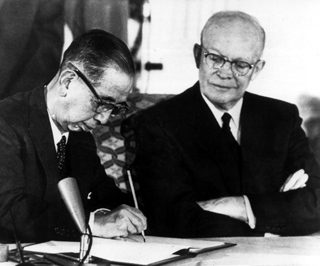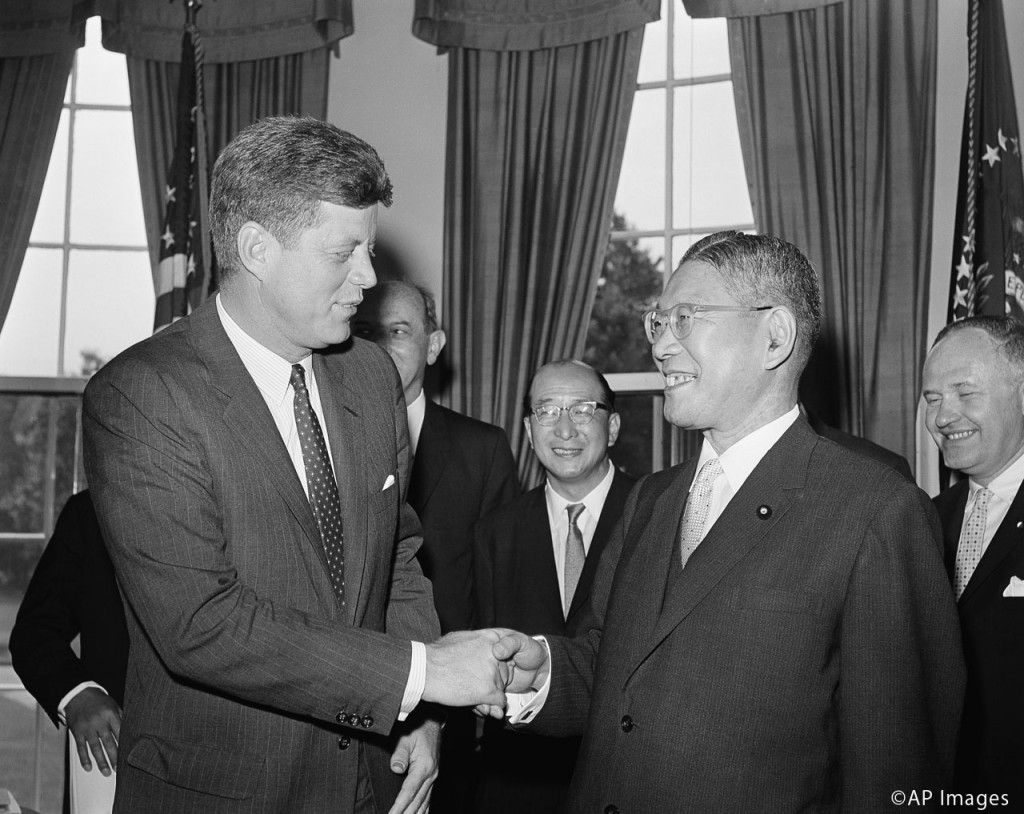“The most important relationship in the world, bar none.”
– former U.S. Ambassador to Japan Mike Mansfield

Emmett “Jerome” Ryan
Months have passed since March 11 when Japan was hit simultaneously by three catastrophes – a devastating earthquake, tsunami, and nuclear reactor disaster – arguably the worst crisis in Japan’s post-WWII history. The Japanese and U.S. military mobilized quickly and decisively in the following days and weeks in a large-scale humanitarian assistance effort in Tohoku. This operation underscored the strength of the U.S.-Japan Alliance, the tangible benefits of that close relationship to Japanese and Americans, and the truth of former U.S. Ambassador to Japan Mike Mansfield’s statement that the U.S.-Japan Alliance is “the most important relationship in the world, bar none.” Indeed, this treaty has endured longer than any other in the last several hundred years.
Former Prime Minister Shigeru Yoshida and then-U.S. Secretary of State Dean Acheson signed the San Francisco Peace Treaty and the U.S.-Japan Security Treaty on September 8, 1951. The U.S. Senate and President ratified the security treaty the next year, and the agreement went into effect on April 28, 1952. The treaty recognized that “Japan as a sovereign nation has the right to enter into collective security arrangements, and further, the Charter of the United Nations recognizes that all nations possess an inherent right of individual and collective self-defense.” Article 1 of the treaty held that Japan granted the United States the right to locate air, land, and sea forces in Japan in order “to contribute to the maintenance of international peace and security in the Far East and to the security of Japan against armed attack …”
Eight years later, on January 19, 1960, former Prime Minister Nobusuke Kishi and then-Secretary of State Christian Herter signed a historic successor treaty to the 1951 agreement, the Treaty of Mutual Cooperation and Security between Japan and the United States of America. Like its predecessor, the treaty committed the United States to deploy military forces to defend Japan if the country came under attack; it also provided port and military basing facilities for U.S. forces in territory administered by Japan. In addition, it committed the United States to consult with Japan before initiating direct combat operations, and unlike its predecessor, had a defined, renewable ten-year term limit. The 1960 version of the treaty also eliminated the right of U.S. forces to intervene in Japanese domestic affairs to quell domestic disturbances. This agreement has endured for over half a century. Today, close to 45,000 U.S. military troops in Japan demonstrate U.S. commitment to the defense of Japan and the maintenance of peace in the region.

Japanese Prime Minister Nobusuke Kishi signs a treaty of mutual security with the United States on Jan. 19, 1960, as President Dwight Eisenhower looks on. (AP Photo/RMB)
Historians have suggested that the outbreak of the Korean Conflict in 1950 served to underscore the urgency of signing a robust security agreement with Japan. The communist attack on the ROK showed the world and policymakers in Japan and in the United States that Japan needed a strong alliance to deter what then appeared to be a clear and imminent threat. Former U.S. diplomat George Kennan suggested in 1964 that U.S. policymakers in 1950-52, i.e., just prior to and after the start of the Korean Conflict, were operating under three major assumptions. First, they assumed Japan was threatened by invasion or overt military intimidation from communist mainland Asia, and only the presence of U.S. troops on the Japanese archipelago deterred that invasion, or threat of invasion. The threat of a future invasion would be avoided only by the continued presence of those forces there. Second, they reasoned that since a similar situation existed with respect to the ROK, any relaxation of U.S. “adroit and vigilant application of counter-force” would cause an immediate renewal of hostilities by Communist North Korea and China. Consequently, it was thought that the security of Japan was tied to the security of the ROK, and that U.S. bases in Japan would be needed in the defense of the ROK in addition to the defense of Japan outright. Third, U.S. policymakers likely believed that the Japanese people themselves shared these same assumptions and would intrinsically understand the importance of the Alliance to their own security, and to the security of the region as a whole.
The security treaty was hailed at the time as providing unprecedented and rich benefits to both Japan and the United States. For Japan, the treaty symbolized the country’s independence and return to the world stage. Through its relationship with the United States, Japan gained security with comparatively lower defense expenditures, which served as an effective hedge against the territorial ambitions of others in the region. Secure under the U.S. nuclear umbrella, Japan was also able to direct financial resources towards its economic recovery, resources that would have otherwise been allocated to defense expenditures. Indeed, Japan has been able to hold its defense budget to less than one percent of GDP over the years. Japanese policymakers and business interests also looked forward to gaining access to the massive U.S. market, close to 30 percent of global GDP at the time (and still the largest market in the world today).
As in Japan, business leaders in the United States were broadly supportive of the Alliance, and eager to take advantage of the region’s financial and economic potential, once stability and secure sea lanes were established. Intellectuals in both countries also supported the Alliance on philosophical and social grounds, given the historic nature of an entente between former enemies – a nascent Asian democracy in the East and the United States in the West. In sum, the Alliance provided (and still provides) significant economic and security benefits to the United States and Japan, countries that emerged from World War II as natural geo-strategic and political partners. More broadly, given its scale, the Alliance provides stability for the global system as a whole.
Our economic and security relationship deepened in the years immediately following the signing of the treaty, but the United States and Japan also benefited from a concomitant increase in cultural and educational exchanges. The number of Japanese students studying abroad in the United States increased, and many of Japan’s young intellectuals were able to pursue academic study in the United States under the Fulbright Program after it was extended to Japan in 1952. NGOs, foundations, and universities also increased their cultural, educational and people-to-people exchanges. For example, John D. Rockefeller III helped established the International House of Japan in 1952, and International Christian University (ICU) opened in 1953.

President John Kennedy shakes hands with Japanese Prime Minister Hayato Ikeda, at right, at the White House in Washington, June 21, 1961. (AP Photo)
At the June 1961 summit between Prime Minister Ikeda and President Kennedy, new cabinet-level U.S.-Japan Joint Committees in trade and economic affairs, cultural, and education exchange, and scientific cooperation were announced. In November 1961, five members of the Kennedy cabinet, including Secretary of State Dean Rusk, attended the first meeting of the U.S.-Japan Committee on Trade and Economic Affairs, held in Hakone. In December of that same year, the first joint U.S.-Japan science meeting was held. Also in 1961, the U.S.-Japan Business Conference was inaugurated. Later in 1962, the committee focusing on cultural and educational exchange laid the groundwork for establishing the U.S.-Japan Conference on Cultural and Educational Interchange (CULCON), a major new institution.
Arguably, the true test of any alliance is its strength during periods of crisis or outright military conflict. Most recently, Japan’s triple disaster on March 11 tested the Alliance in ways unimagined by the original architects of the accord back in 1952. Operation Tomodachi and the unprecedented scale of the joint humanitarian relief effort of U.S. and Japanese military forces showed observers around the world that the Alliance is rock solid, and adds tremendous value outside of outright military contingencies. As President Obama said immediately after the disaster, “The United States stands ready to help the Japanese people in this time of great trial. The friendship and alliance between our two nations is unshakeable, and only strengthens our resolve to stand with the people of Japan as they overcome this tragedy.”
Over the decades, the Alliance changed in response to evolving security challenges in the region and around the globe. As Japan’s role in global affairs has grown, the Alliance has grown with it. During the 1990-1991 Persian Gulf War, Japanese car carriers transported American equipment to the region and even raised taxes in order to contribute close to USD 13 billion to the war effort. Although constitutional restrictions prevented Japan from deploying troops to the conflict, Japan in 1992 eventually passed peace-keeping operations (PKO) legislation allowing the dispatch (under United Nations auspices) of Japanese Self-Defense Forces to conflict zones in the future. Japanese troops have since engaged in PKO missions in Cambodia, the Democratic Republic of the Congo, East Timor, Mozambique, the Golan, and Rwanda. In addition, from 2001 to mid-January 2010, Japanese Maritime Self-Defense Forces stationed refueling ships in the Indian Ocean to supply fuel to coalition forces fighting in Afghanistan. Japan also committed Ground Self-Defense forces to the Iraq War effort.
As the Alliance entered the 21st century, its relevance in securing peace and security in Northeast Asia showed no sign of waning. U.S. and Japanese regional leadership, codified by the treaty, enjoyed the support of other nations in the region. Although significant cuts in troop strength were initially examined in the euphoria of the immediate post-Cold War environment, those reductions never materialized as it became increasingly obvious that the United States and Japan needed to maintain a stable force posture in the region. The most immediate threat to the region came from North Korea, which maintains a million-man army and continues to build its nuclear weapons and ballistic missiles programs.
Although some critics have suggested that in the post-Cold War environment the United States could no longer afford to forward deploy forces to Japan, that argument was soon put to rest. Indeed, this thesis is valid only if the United States were to cut its overall troop strength. The Japanese government pays approximately 70 percent of the cost of basing troops in Japan. Redeploying those troops off the Japanese archipelago and back to mainland U.S. bases would increase associated maintenance costs for the United States, not decrease them. For its part, Japan, too, has reaffirmed the relevance and advisability of an interdependent, balanced Alliance with the United States in the 21st century.
Japanese and U.S. leaders have been unequivocal in stating that the U.S.-Japan Security Alliance is the lynchpin of their respective nations’ East Asia security policies. These statements, coupled with the transparency of U.S. and Japanese troop strength serve to continue to protect the Japanese homeland and deter dangerous neighbors, such as North Korea under Kim Jong Il. The Alliance also serves to reassure other Asian countries that the United States is in the region to stay and is committed to maintaining the long-term stability of Northeast Asia. Over the past five decades, the United States and Japan have maintained, strengthened and tailored our mutually beneficial security arrangement. The treaty has stood the test of time, through periods of conflict, such as the Korean War, the Vietnam Conflict, and two Gulf wars, as well as through long periods of peace. Both countries emerged from the Cold War with an acute understanding of the importance of the Alliance in an ambiguous world no longer clearly defined in bipolar terms. Clearly, it is in the interests of the United States, Japan, and Northeast Asia to maintain the current U.S.-Japan security relationship because this Alliance relationship, along with the U.S.-ROK security treaty, serves as a necessary component for regional stability.
Broadly speaking, this Alliance between prosperous democracies in the Pacific, that share a common commitment to democracy, free market capitalism, and universal human rights such as freedom of expression, brings stability, peace and prosperity to Asia. It has made Asia a better, safer place. Even in the post-Cold War era, during which the likelihood of all-out nuclear Armageddon has receded, there is no shortage of threats to our collective security. Outright military contingencies notwithstanding, the mutually-reinforcing and symbiotic relationship between the defense forces of both our nations has and will continue to deter regional aggression, while stabilizing regional tensions. In that context, Japan, the United States, and other Asian nations are free to enjoy all the benefits a secure environment provides, particularly free trade and commerce. It’s seductively persuasive to think that peace is the natural state of being, but as Joseph Nye, the former Director of the Center for International Affairs at Harvard University and a former Assistant Secretary of Defense, said succinctly in 1995, “security is like oxygen, you tend not to notice it until you need it.” Democracies during times of peace never find it easy to take preemptive measures to head off crises or conflicts, but the very existence of the U.S.-Japan Alliance has, undoubtedly, deterred many aggressors and has forestalled many security crises before they even started. It continues to do so, every day.
Looking forward, in the words of current Ambassador John V. Roos, “the abiding commitment of our two nations to this Alliance will be crucial to making it even more indispensable over the next 50 years than it has been for the last 50 years. Both partners, working as equals, must keep it robust, fresh, and forward-looking, so that this alliance we share continues to function as an indestructible partnership that protects each of our citizens and serves the vital national interests of both of our countries.”
Jerome Ryan is a Second Secretary in the Political Section of U.S. Embassy Tokyo. He has been a member of the Foreign Service since 2004. His regional specialization is East Asia where he has served in Osaka, Seoul and Tokyo, covering political matters.







COMMENTS0
LEAVE A COMMENT
TOP